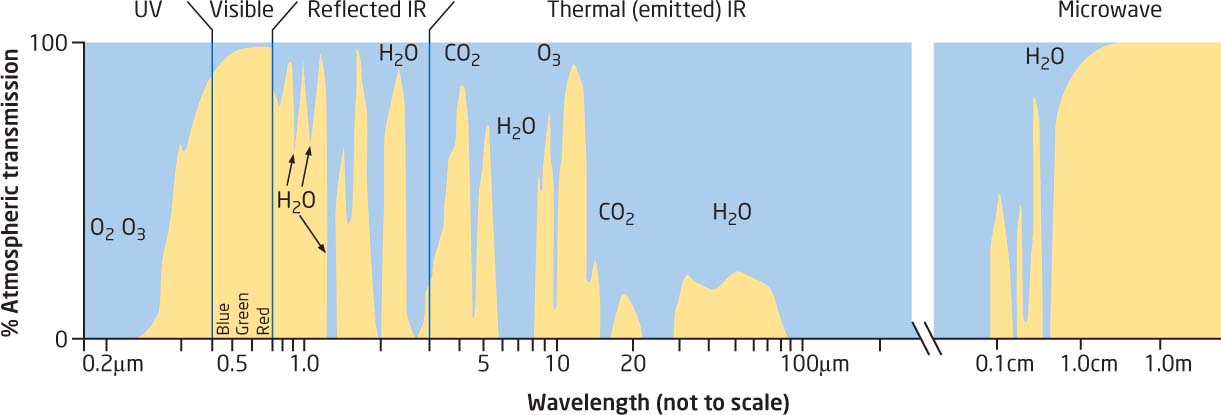10.2 
What Is the Role of the Atmosphere in Remote Sensing?

Earth’s atmosphere acts like a shield around the planet, and the energy from the Sun has to pass through it before it reaches Earth’s surface. As a result, a significant amount of the Sun’s electromagnetic energy never actually makes it to the ground—and if it never makes it to the ground, it’s never going to be reflected back up to the remote sensing device (and will never be part of the whole remote sensing process). Earth’s atmosphere contains a variety of gases (including carbon dioxide and ozone) that serve to absorb electromagnetic energy of numerous wavelengths. For instance, ozone absorbs wavelengths of energy that correspond to ultraviolet light; these are “UV rays” that can be harmful to humans. Thus, a considerable amount of ultraviolet radiation gets trapped in the atmosphere, and doesn’t pass through to Earth. Very short wavelengths and some very long wavelengths are also absorbed by the atmosphere.
atmospheric windows those wavelengths of electromagnetic energy in which most of the energy passes through Earth’s atmosphere
Those wavelengths of energy that pass through the atmosphere (rather than being absorbed) are referred to as atmospheric windows. Remote sensing of the wavelengths that make up these “windows” is possible since they are the ones that transmit most of their energy through the atmosphere to reach Earth. The visible light wavelengths of the electromagnetic spectrum (wavelengths between 0.4 and 0.7 micrometers) are examples of atmospheric windows. Most of the energy at these wavelengths is not absorbed by the atmosphere and instead transmits to Earth, where it reflects off objects and surfaces to be viewed by our eyes as color (and viewed also by cameras and satellite sensors). Other windows used in remote sensing include portions of the infrared and thermal infrared sections of the spectrum (see Figure 10.4 for a diagram of the atmospheric windows). Sensors are set up to measure the energy at the wavelengths of the windows. It won’t do any good whatsoever to have a sensor measuring wavelengths (such as the entire ultraviolet portion of the spectrum) that are completely absorbed by the atmosphere, as there will be no reflectant energy to measure.

Rayleigh scattering scattering of light caused by atmospheric particles smaller than the wavelength being scattered
While some light energy is absorbed by the atmosphere, other light energy is scattered by it. Scattering is caused by particles, such as dust and water, in the atmosphere—it is always present, but its effects are always unpredictable. Light hitting these particles will be absorbed and redirected back out in random directions, causing scattering. There are three types of scattering that can occur: The first of these is Rayleigh scattering, which occurs when the particles causing the scattering are significantly smaller than the wavelengths being affected. Keeping in mind that the visible-light wavelengths are smaller than one-millionth of a meter, Rayleigh scattering is caused by molecules in the atmosphere. In addition, shorter wavelengths are scattered to a much greater degree than longer wavelengths. This explains why the sky is blue during the day: The shorter blue wavelengths are scattered far more than the longer red wavelengths. However, at sunset or sunrise, sunlight has a longer way to travel to reach Earth, and thus with all of the blue wavelengths already scattered, we see the reds and oranges of longer wavelengths as the Sun goes out of view.
333
Mie scattering scattering of light caused by atmospheric particles the same size as the wavelength being scattered
nonselective scattering scattering of light caused by atmospheric particles larger than the wavelength being scattered
The second is Mie scattering, which occurs when the particles causing the scattering are roughly the same diameter as the wavelengths they’re scattering (this would include things like dust or smoke). The third is nonselective scattering, where what’s causing the scattering—say, water droplets or clouds—is larger than the wavelengths being scattered and scatters all wavelengths equally. Nonselective scattering also explains why we see clouds as white—the visible primary colors of blue, green, and red are all scattered the same, and equal levels of red, green, and blue will produce the color white.